At first, the useless floated downstream a couple of at a time. Then they got here by the tons of, after which the 1000’s.
For mile after mile, the Klamath River was stuffed with tens of 1000’s of useless salmon. As Annelia Hillman paddled a canoe with a good friend one September day 21 years in the past, her coronary heart sank when she noticed the carcasses floating previous. She and different members of the Yurok Tribe say they are going to always remember the stench of loss of life.
“It’s like seeing your loved ones perish in entrance of you,” Hillman mentioned. “I’d examine it to a bloodbath, actually, when it comes to the feelings and the trauma that it has precipitated for us.”
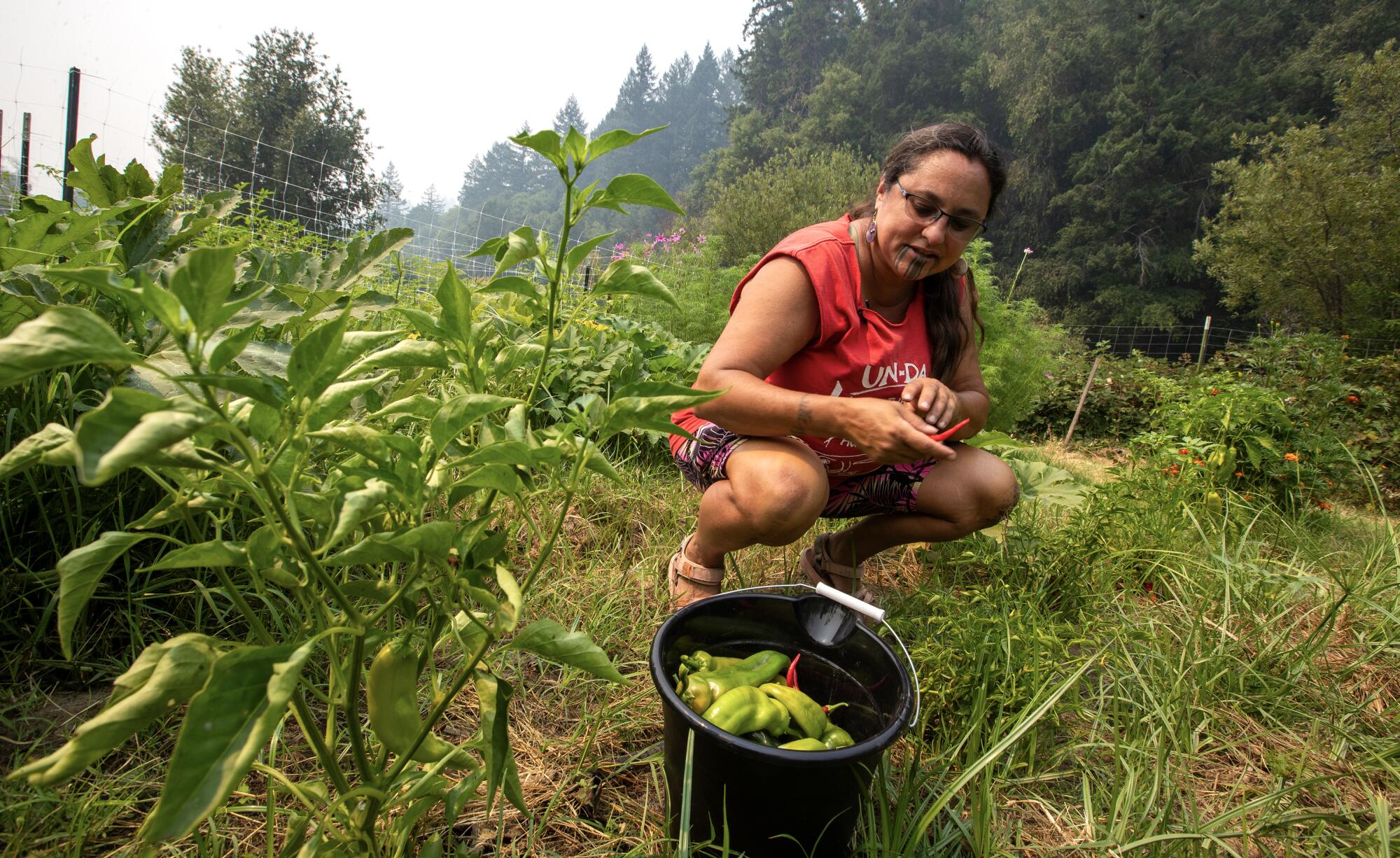
Annelia Hillman, a standard meals coordinator for the Yurok Tribe, picks greens in a group backyard on the Klamath River.
(Brian van der Brug / Los Angeles Instances)
The grief drove Hillman, then 27, to start protesting to demand change. The mass fish kill of 2002, estimated at as much as 70,000 salmon, grew to become a defining occasion for a era of younger Native activists — a second that confirmed the river ecosystem was gravely sick, and badly in want of rescuing.
Water diversions for agriculture had dramatically shrunk river flows. And the Klamath’s hydroelectric dams, which had lengthy blocked salmon from reaching their spawning areas, had degraded the water high quality, contributing to poisonous algae blooms and illness outbreaks among the many fish.
Aggressive and impactful reporting on local weather change, the surroundings, well being and science.
At first, when Indigenous leaders demanded that dams be eliminated, their probabilities of success appeared distant at finest. However after greater than twenty years of persistent efforts, together with protests at firm shareholder conferences, demonstrations on the river and complex negotiations, the 4 dams alongside the California-Oregon border have lastly began to be dismantled.
One small dam has already been eliminated, and three extra are slated to come back down subsequent yr.
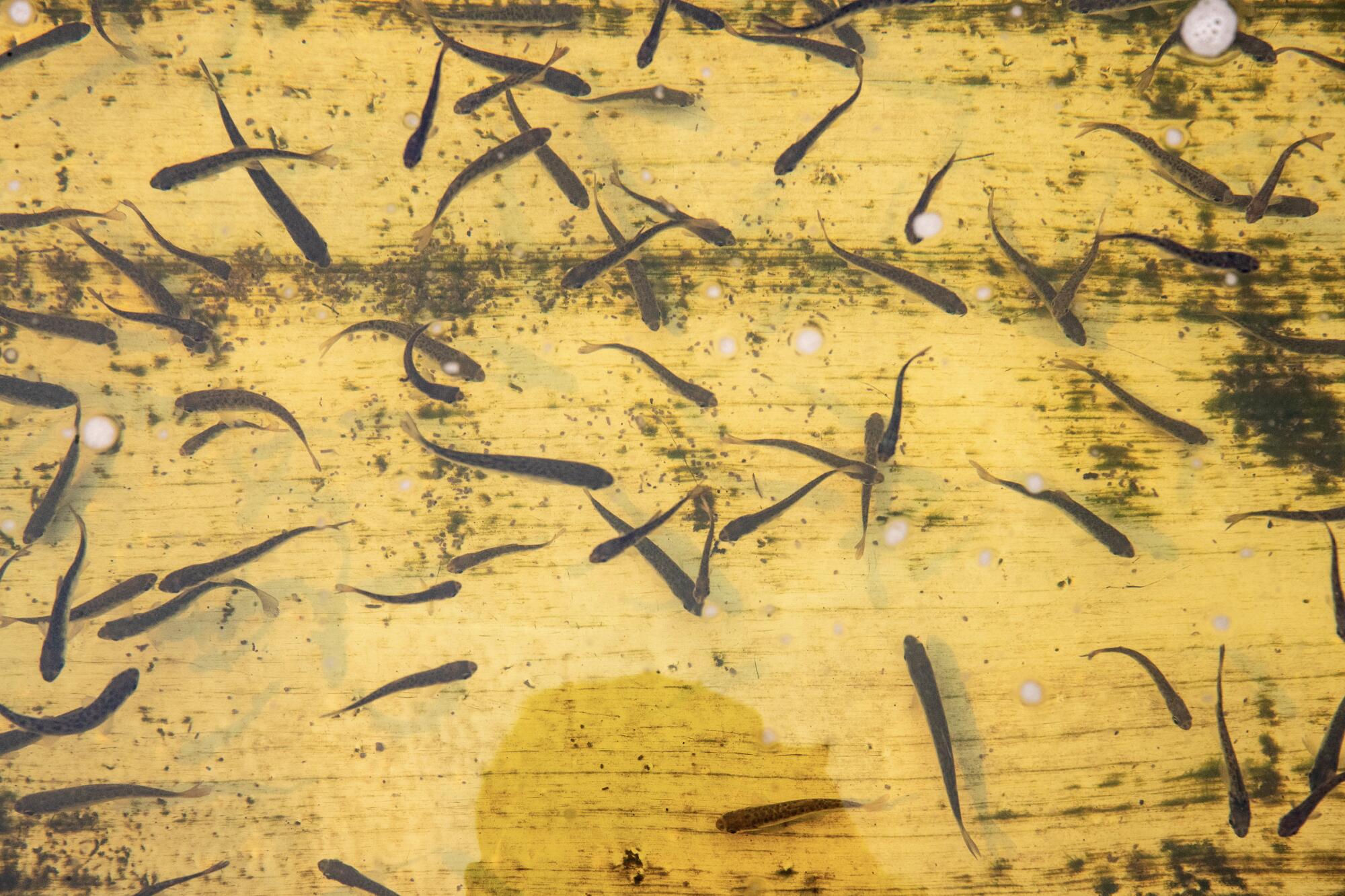
Chinook salmon swim on the Iron Gate Fish Hatchery under the dam on the Klamath River.
(Brian van der Brug / Los Angeles Instances)
For members of the Yurok, Karuk and different tribes who’ve been immersed within the wrestle for a lot of their lives, the undamming of the Klamath represents a chance to heal the ecosystem and assist fish populations get well by opening up tons of of miles of spawning habitat. They are saying the approaching adjustments maintain promise for them to strengthen their ancestral connection to the river and maintain their fishing traditions alive.
“This river is our lifeline. It’s our mom. It’s what feeds us. It’s the inspiration to our individuals, for our tradition,” Hillman mentioned. “Seeing the restoration of our river, our fisheries, I believe goes to uplift us all.”
Work on the dam removing undertaking started in June. The smallest dam, Copco No. 2, was torn down by crews utilizing heavy equipment. The opposite three dams are set to be dismantled subsequent yr, beginning with a drawdown of the reservoirs in January.
“The size of that is monumental,” mentioned Mark Bransom, CEO of the nonprofit Klamath River Renewal Corp., which is overseeing dam removing and river restoration efforts. “That is the most important dam removing undertaking ever undertaken in the US, and maybe even the world.”
The $450-million funds contains about $200 million from ratepayers of PacifiCorp, who’ve been paying a surcharge for the undertaking. The Portland-based utility — a part of billionaire Warren Buffett’s conglomerate Berkshire Hathaway — agreed to take away the ageing dams after figuring out it will be cheaper than attempting to deliver them as much as present environmental requirements.
The dams had been used purely for energy era, to not retailer water for cities or farms.
“The explanation that these dams are coming down is that they’ve reached the top of their helpful life,” Bransom mentioned. “The facility generated from these dams is mostly a trivial quantity of energy, one thing on the order of two% of the electrical utility that beforehand owned the dams.”
A further $250 million got here by way of Proposition 1, a bond measure handed by California voters in 2014 that included cash for eradicating limitations blocking fish on rivers.

A tunnel, left, at Iron Gate Dam, the place modifications are underway. The tunnel will probably be used to empty the lake early subsequent yr.
(Brian van der Brug/Los Angeles Instances)
Crews employed by the contractor Kiewet Corp. have been engaged on roads and bridges to organize for the military of excavators and dump vehicles.
“We’ve 1000’s of tons of concrete and metal that make up these dams that we now have to take away,” Bransom mentioned. “We’ll in all probability find yourself with 400 to 500 staff on the peak of the work.”
Throughout a go to in August, Bransom stood on a rocky bluff overlooking Iron Gate Dam, the place crews had been engaged on a water drainage tunnel.
There gained’t be main dam-wrecking explosions, he mentioned, however staff plan to blast open some dam tunnels to maneuver out tons of gathered sediment from the reservoirs. Because the water is drained, crews engaged on boats will even spray fireplace hoses to clean away muddy silt and ship it downstream.
Along with tearing down the dams, the undertaking entails restoring about 2,200 acres of reservoir backside to a pure state.
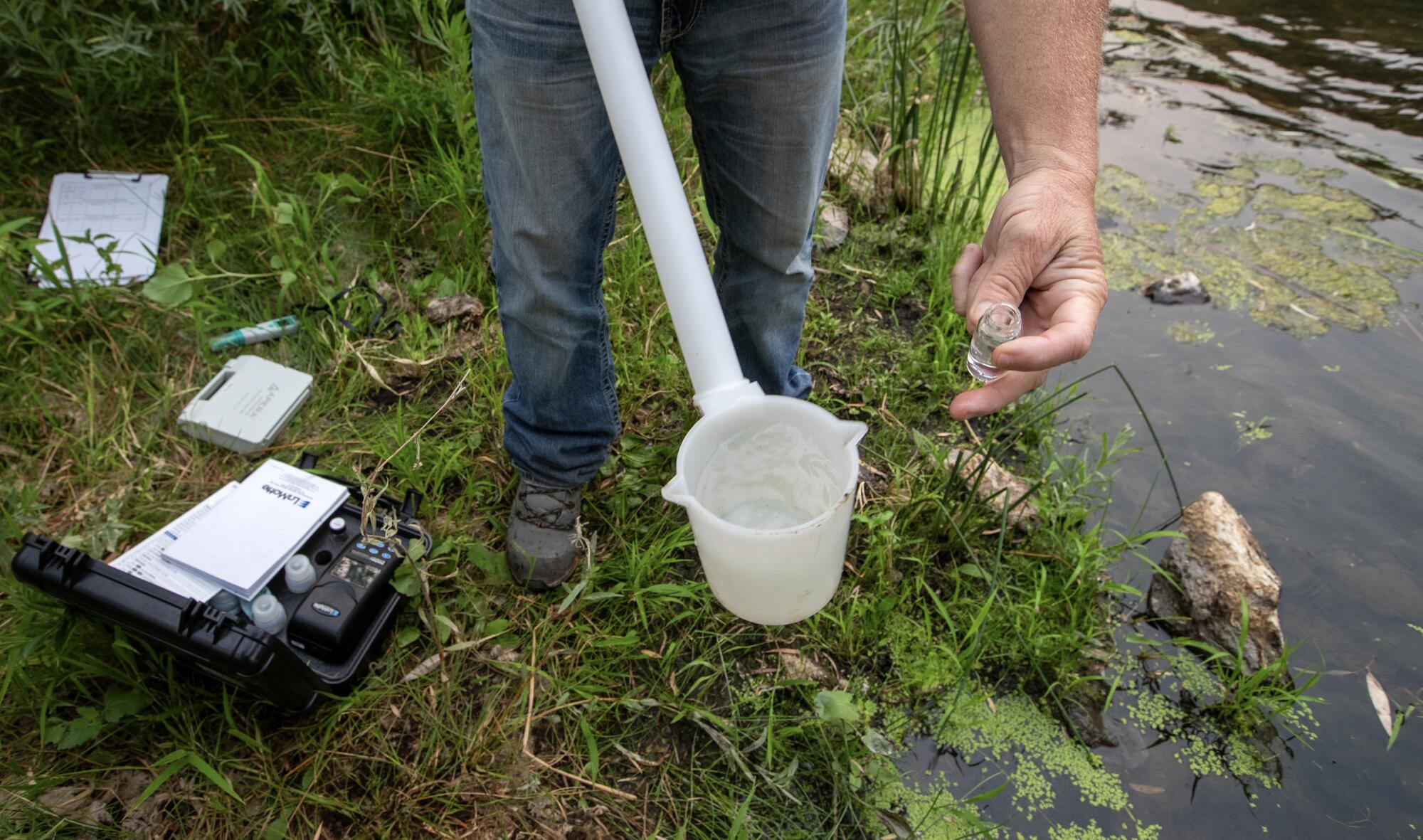
A Klamath River Renewal Corp. biologist takes water samples.
(Brian van der Brug/Los Angeles Instances)
In recent times, staff have collected almost 1 billion seeds from native vegetation alongside the Klamath and despatched seeds to farms to be planted and harvested. That has produced almost 13 billion seeds — 26 tons in all — which will probably be planted as soon as the reservoirs are drained.
The goal is for native vegetation to regrow throughout the watershed whereas fish start to entry 420 miles of spawning habitat within the river and its tributaries.
“Nature is aware of what it needs to do. So what we’re actually attempting to do right here is figure with Mom Nature to create situations that can permit for river therapeutic and for restoration of stability right here,” Bransom mentioned. “We are able to supply a light-weight contact to assist nudge issues in the suitable course.”
Fed by Cascade Vary snowmelt, the Klamath River takes form amongst lakes and marshes alongside the California-Oregon border and winds by way of steep mountainous terrain earlier than ending its journey amongst redwood forests on the Pacific Coast.
For the Yurok, the combat to take away dams is the newest in a sequence of struggles over the river’s administration and the preservation of their lifestyle.
Susan Masten, a number one advocate for tearing down the dams, recollects a time in 1978 that the Yurok name the “Salmon Wars,” when federal brokers descended on the reservation to implement a ban on fishing.
Simply 5 years earlier, the U.S. Supreme Courtroom had affirmed the tribe’s fishing rights in a landmark case involving Masten’s uncle, Raymond Mattz. However federal officers had ordered a halt to tribal fishing on the Klamath whilst different fishing continued alongside the coast.
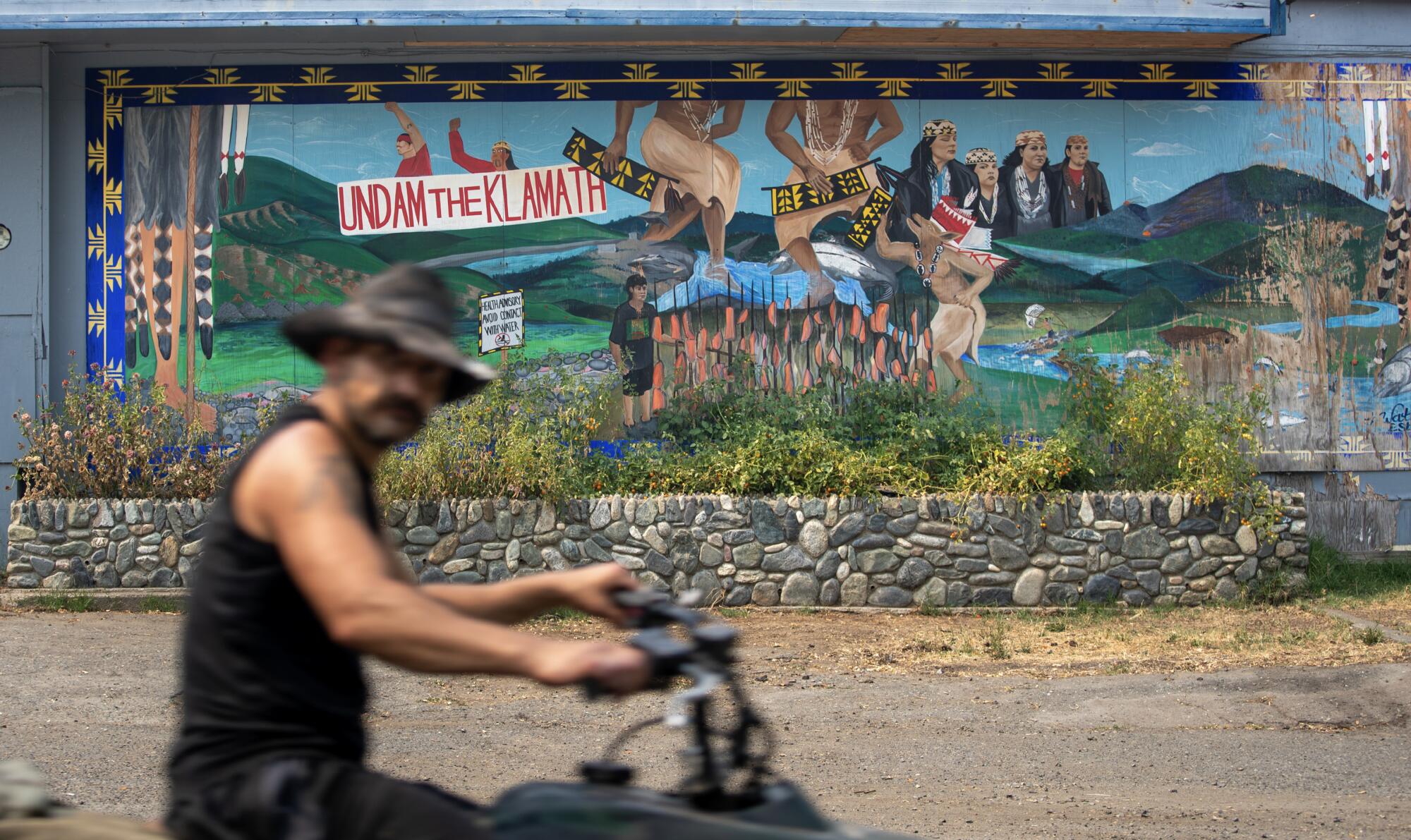
A person rides previous an “Undam the Klamath” mural on the Orleans Market in Orleans.
(Brian van der Brug / Los Angeles Instances)
The Yurok, who sought to defend their fishing rights and tribal sovereignty, confronted off with officers in riot gear holding billy golf equipment and M-16 rifles. Many residents feared for his or her lives, Masten mentioned.
Masten recalled seeing officers drag a lady away by her hair as tribe members protested on a riverbank. One other time, she mentioned, brokers twisted her grandfather’s arm behind his again.
The tensions ultimately subsided when the marshals left, and the Yurok efficiently asserted their rights to proceed fishing. However they noticed different threats within the declining fish populations — and the 4 hydroelectric dams that had been constructed with out tribal consent between 1912 and the Nineteen Sixties.
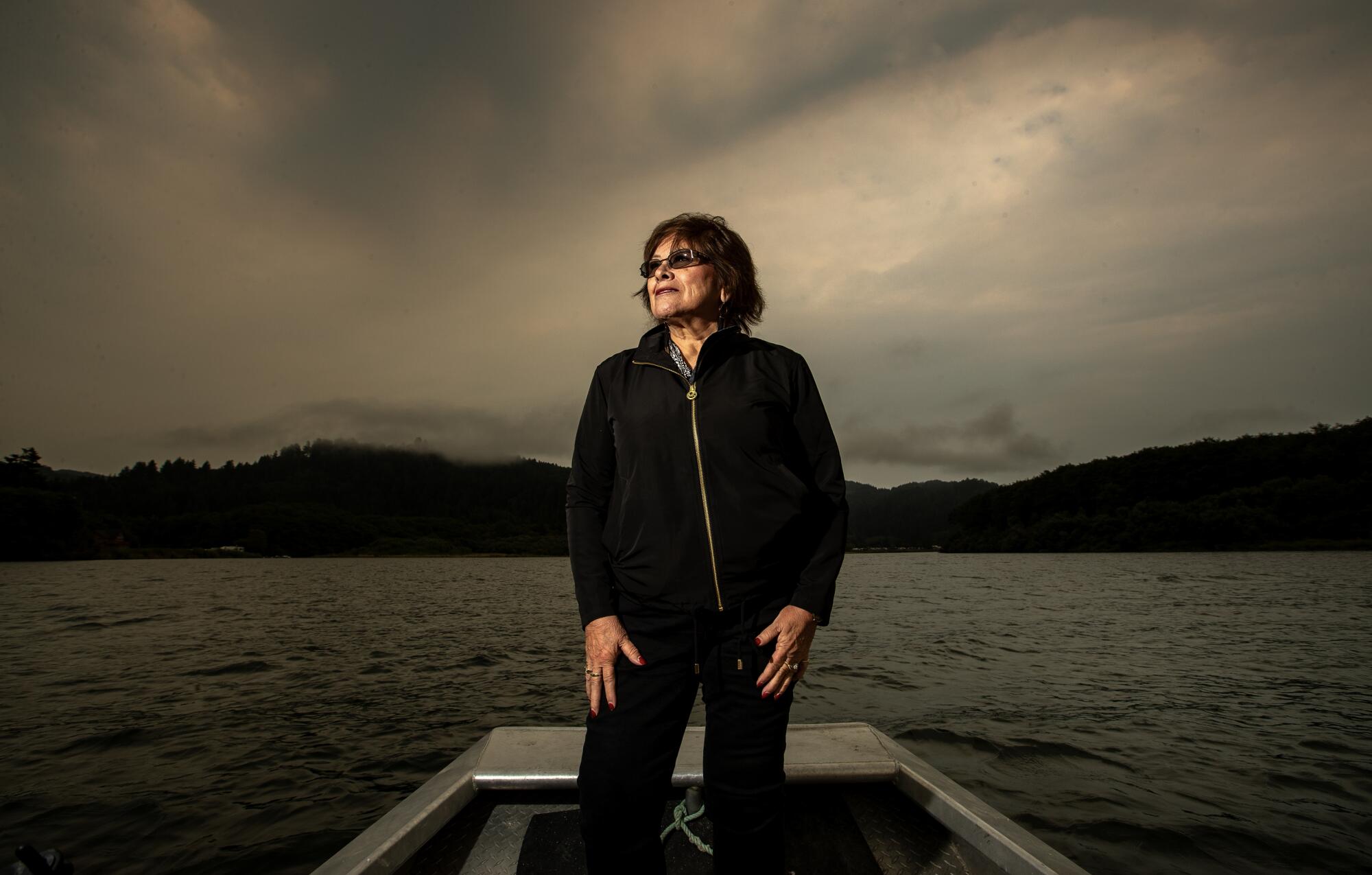
Former Yurok tribal chairperson Susan Masten stands on a ship on the Klamath River.
(Brian van der Brug/Los Angeles Instances)
Masten, who was the tribe’s chairperson in the course of the devastating fish kill of 2002, was ecstatic when federal regulators signed off on plans to demolish the dams.
“I actually didn’t suppose that I’d see dam removing in my lifetime,” Masten mentioned.
Masten, who’s 71, spoke whereas drifting throughout the estuary in a motorboat close to the river’s mouth. Because the surf crashed in opposition to a barrier of sand, pelicans, cormorants and ospreys soared over the darkish water.
“Every little thing that’s round right here is related to this river,” Masten mentioned. “And so for us to make sure the longer term for our youngsters, we have to be certain that this river is right here and that it’s wholesome, and that the ecosystem is wholesome, as a result of it’s the heartbeat of our individuals. It’s the lifeway of our individuals.”
Masten lives in her ancestral village of Rek-woi, or Requa, in a house on a bluff overlooking the river’s mouth. As soon as the dams come down, she mentioned, she expects to see the fish thrive and all the ecosystem flourish.
“The river has a option to heal itself, and it may possibly heal itself in a short time if it’s allowed to take action,” Masten mentioned. “I’m excited that my grandchildren will have the ability to profit from it.”
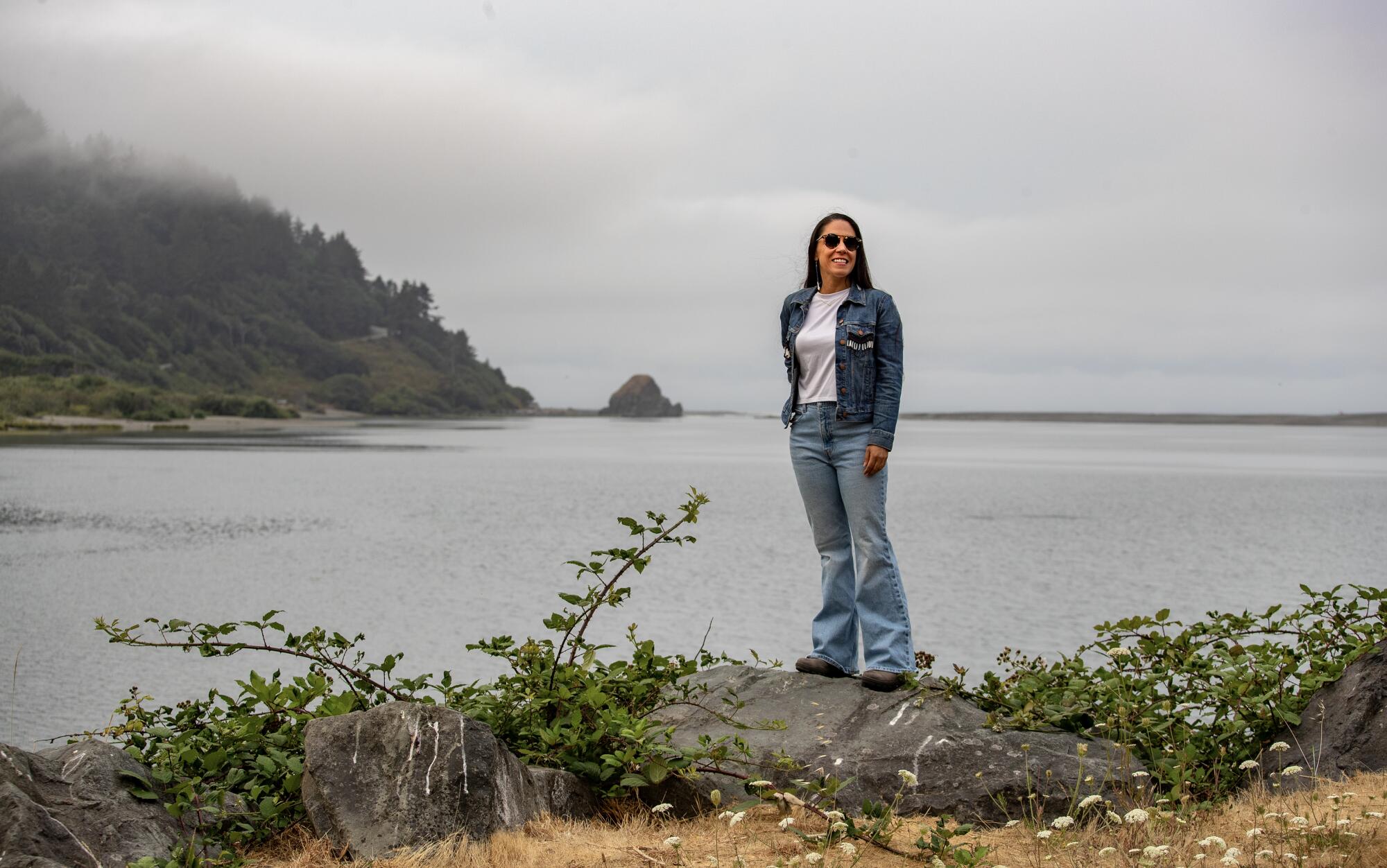
Yurok tribal lawyer Amy Bowers Cordalis, a pacesetter of the Indigenous conservation group Ridges to Riffles, stands beside the boat ramp within the village of Requa close to the mouth of the Klamath River.
(Brian van der Brug / Los Angeles Instances)
Masten’s niece, Amy Bowers Cordalis, is a lawyer for the tribe who focuses on the Klamath River and was concerned in negotiating agreements involving California, Oregon and PacifiCorps to allow dam removing.
“We saved pushing and pushing,” Bowers Cordalis mentioned. “All of us got here collectively and found out a option to take away dams.”
She stood by a ship ramp that in August sometimes can be bustling with households hauling out their nets and fish. However the ramp was principally abandoned.
The tribe’s leaders took the uncommon step of canceling subsistence fishing this yr to guard the dwindling salmon inhabitants, a call that mirrored the shutdown of economic fishing alongside the coast.
A number of years in the past, Bowers Cordalis additionally labored on the Yurok Tribe’s declaration of the river as a authorized “individual” below tribal legislation, a step supposed to offer better protections.
One key downside, she mentioned, is that the dams have allowed nutrient-filled agricultural runoff to fester in lakes, feeding algae blooms. When the river isn’t secure for bathing, it prevents the tribe’s members from finishing up ceremonies that contain coming into the water.
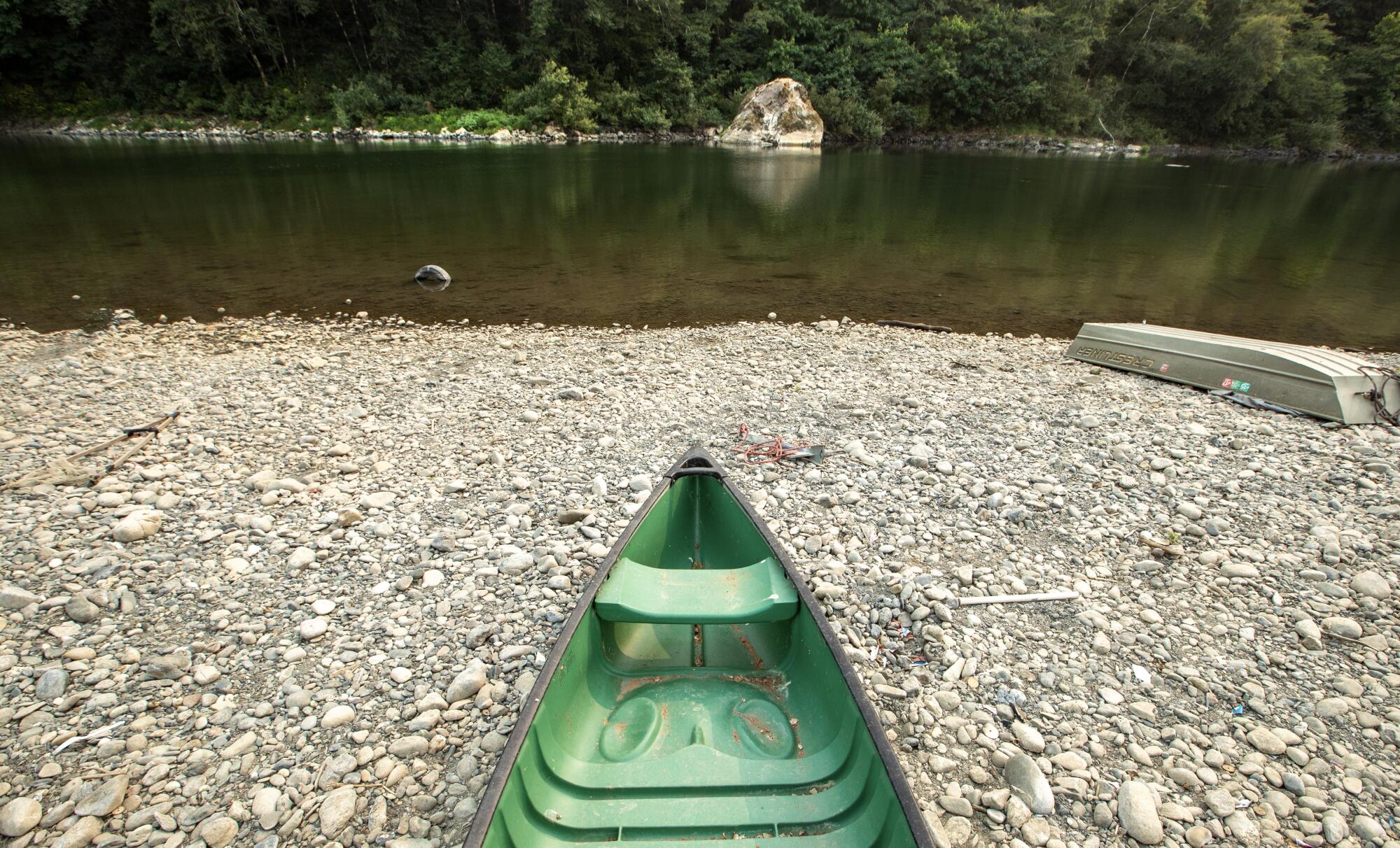
An idle canoe sits on the shore at a fishing camp alongside the Klamath River.
(Brian van der Brug / Los Angeles Instances)
Tearing down the dams is a primary step in “a brand new period of therapeutic,” Bowers Cordalis mentioned. She mentioned she hopes to ultimately get again the flourishing river with plentiful fish that her nice grandmother noticed a century in the past.
From the river behind her, a salmon flew into the air, its scales shimmering, and landed within the water with a plop. Then one other salmon jumped.
“A giant run simply went by way of!” a person known as out from a ship.
Bowers Cordalis mentioned it was encouraging to see that some salmon, even with their inhabitants so low, had been making it upstream to spawn.
“We’ve a lot hope that this river will restore itself,” Bowers Cordalis mentioned. “Dam removing is only the start. Dam removing is the top of colonization of this river.”
Not everyone seems to be comfortable to see the dams go. In some areas, the removing undertaking has generated heated opposition.
Locally of Copco Lake, some residents reside in waterfront properties with boats and docks. Their properties will probably be left excessive and dry when the reservoir is drained.
Alan Marcillet, a resident who enjoys kayaking, mentioned most individuals locally aren’t trying ahead to the disruptive adjustments.
“It’s simply going to be a mud pit,” Marcillet mentioned. “The group will simply die. I’d consider the hundred people who reside up right here, maybe half of them gained’t return.”
Two of his neighbors, German and Jeanne Diaz, purchased their retirement dwelling overlooking the lake greater than twenty years in the past. Now, their view is about to alter dramatically, and so they say they’re involved about whether or not the mud that’s uncovered on the backside of the reservoir will flip to mud and pollute the air.
“What’s it going to do to the group?” German Diaz mentioned. “Are we going to be going by way of sandstorms for some time?”

Copco Lake resident Geneve Spanauss Tougher seems to be over Western Outside Information tabloids from the 1970’s at her dwelling.
(Brian van der Brug / Los Angeles Instances)
The Klamath River Renewal Corp. has been accepting claims from landowners to pay for damages linked to dam removing. However Diaz mentioned he doesn’t plan to use for that cash.
“We’ve already seen property values drop,” Diaz mentioned. “What can we do?”
Different residents mentioned they see the reservoir as helpful as a result of it attracts wildlife and serves as a water provide for firefighting helicopters.
Geneve Spannaus Tougher, an 80-year-old resident whose nice grandfather as soon as owned an apple orchard on lands now submerged by the reservoir, mentioned she and plenty of others strongly oppose draining the lake.
“It’s simply going to alter the entire situation of the group,” she mentioned. “I don’t suppose we all know what we’re going to get.”

Due to a closed salmon fishing season, none was avaialble at this yr’s Yurok Salmon Pageant in Klamath.
(Brian van der Brug / Los Angeles Instances)
This August, when the Yurok Tribe held its annual Klamath Salmon Pageant, no salmon was served. As an alternative, there have been tri-tip sandwiches and frybread, and the parade featured a skit about dam removing with individuals holding giant paper cutouts of fish.
At one stand, individuals had been requested to jot down a couple of phrases on playing cards about their hopes for the Klamath River’s future. The playing cards had been held on strings. One learn: “I want for the salmon to get well and run free ceaselessly!”
Close by, T-shirts had been being bought with an illustration depicting the undamming. It contains a younger lady, her eyes lined with ceremonial bluejay feathers, balancing two baskets just like the scales of justice as water breaks by way of a dam and surges into the river.
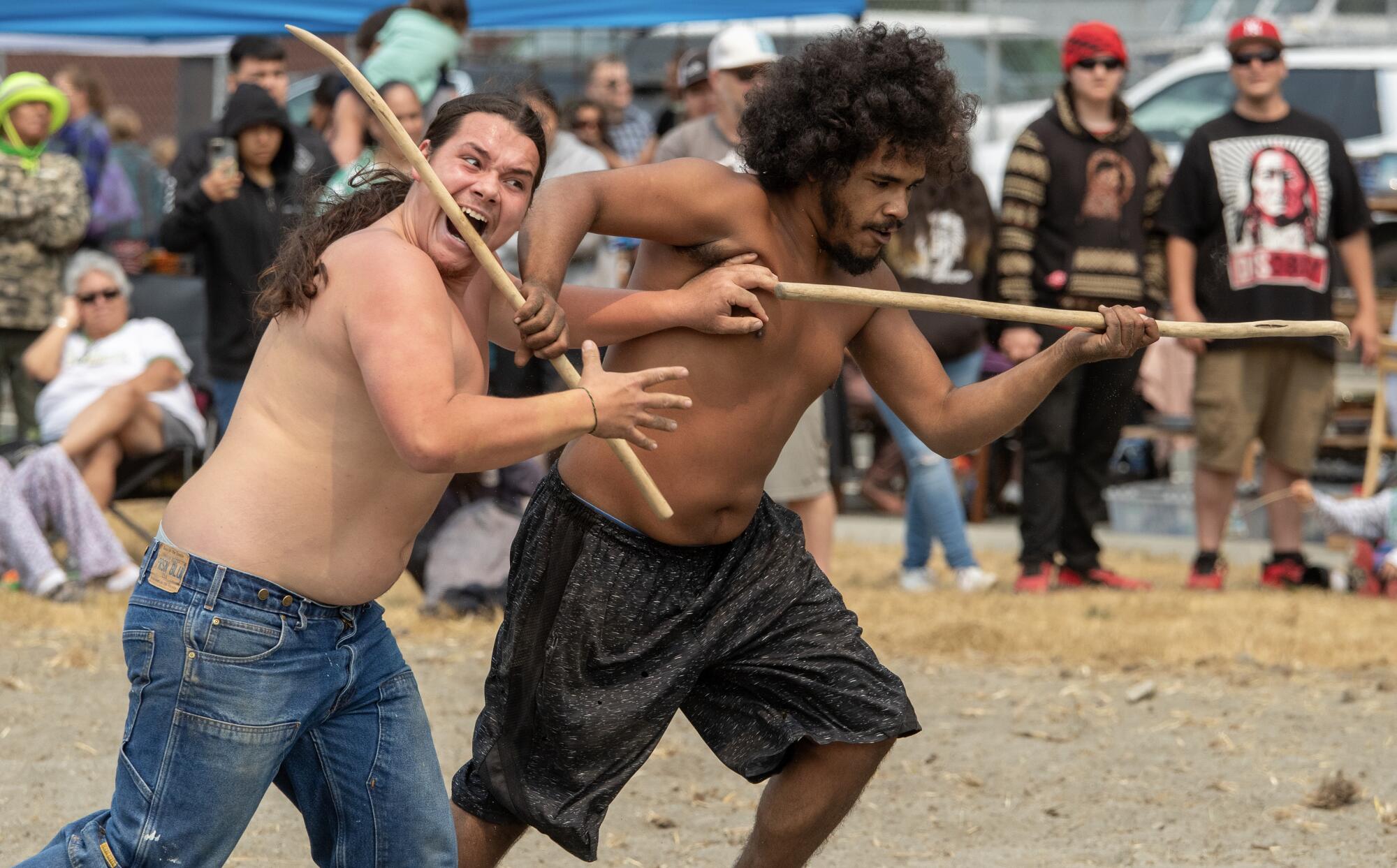
Younger males compete in a Yurok Tribe stick recreation event in the course of the Yurok Salmon Pageant.
(Brian van der Brug/Los Angeles Instances)
The artist, 23-year-old Tori McConnell, mentioned the younger lady represents each the individuals and the river in a state of transition. The tears operating down her cheeks are like her prayers, McConnell mentioned, “overflowing into the hampers of justice.”
McConnell, a Yurok Tribe member who is that this yr’s Miss Indian World, mentioned she is hopeful.
“There’s plenty of work to be performed to revive the salmon inhabitants,” McConnell mentioned. “However I hope we’ll see that occur in our lifetime.”
Populations of chinook and coho salmon, in addition to different fish, have declined greater than 90% within the Klamath over the previous century, mentioned Barry McCovey Jr., the Yurok Tribe’s fisheries director.
The dams have been a giant issue, he mentioned, and “we now have our eyes on righting that mistaken.”
However fish populations have additionally been ravaged by different components, together with gold mining that scarred the watershed, and a long time of logging that left denuded areas, releasing fish-harming sediment into the river.
Moreover, fireplace suppression in forests over the past century and the dearth of conventional burning by Indigenous individuals has left forests primed for catastrophic wildfires, unleashing tainted runoff that turns into “poison to the ecosystem,” McCovey mentioned.
“You mix all that collectively, and then you definitely layer on prime of that local weather change,” he mentioned.
The Klamath’s water is closely used to serve agriculture, irrigating crops corresponding to onions and hay. The Yurok Tribe is suing the federal authorities over selections that they argue don’t present the minimal flows required for fish, together with threatened coho salmon.

Yurok tribe fisheries biologist Barry McCovey on the mouth of the Klamath River.
(Brian van der Brug / Los Angeles Instances)
The removing of dams is a pivotal milestone and it comes at a important time for struggling salmon populations, McCovey mentioned, however restoration isn’t going to occur in a few years.
“We’ve to just accept that these items take time,” McCovey mentioned.
“I don’t suppose in my lifetime I’ll ever see a totally recovered Klamath River ecosystem,” he mentioned. “And perhaps nobody will ever see that. However the purpose is to maneuver nearer to that.”
McCovey mentioned restoring stability to the ecosystem will take generations, and he’s ready to proceed working towards that purpose.
Within the meantime, he and others have been speaking about what they are going to do as soon as all of the dams are gone.
McCovey mentioned he hopes to take a rafting journey, touring for miles with the present because the river flows freely as soon as once more.
#Indigenous #individuals #dismantling #Klamath #River #dams #stirs #hopes #restoring #salmon

